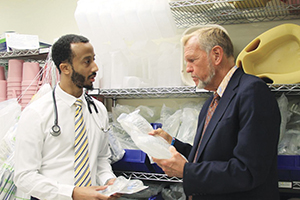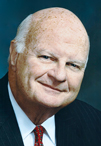By NANCY FRAZIER O'BRIEN
Physicians are a critical link in the chain of controlling health costs. That's why residents and medical students at Trinitas Regional Medical Center in Elizabeth, N.J., are learning to consider costs as one of the variables when they select among different lab tests, medical supplies and prescription drugs. Without this top-of-mind awareness, doctors can unwittingly make decisions that drive up the cost of treatment and can do so without improving patient outcomes.

Dr. Angel Garcia, chief resident of internal medicine at Trinitas Regional Medical Center in Elizabeth, N.J., and Tim Glennon, director of value analysis at Trinitas, look through supplies in a hospital supply room.
Trinitas Regional Medical Center
As payers continue the shift from fee-for-service to value-based care, they are paying based on patient outcomes and leaving providers on the hook for any excess spending and waste.
"Everything today is about health care dollars," said Nancy DiLiegro, the hospital's vice president of clinical operations and physician services and its chief clinical officer. DiLiegro started the initiative to sensitize new doctors to cost pressures in health care and educate them about ways they can make a difference by reducing waste and choosing the right product for the task at hand.
For example, when setting up to change a wound dressing, a clinician can choose to use a basic sterile pad or a quilted underpad that costs seven times as much but provides no added clinical benefit to the patient undergoing the procedure. The students learn small savings add up.
Customer as boss
While controlling costs is important, patient outcomes are the gold standard in value-based payment structures. Gary S. Horan, Trinitas president and chief executive, said in a news release that the value analysis training that Trinitas provides to residents and medical students "is designed to align patient outcomes with our cost-containment initiatives, while ensuring that patient quality is never compromised.

DiLiegro
"Educating our future doctors is more critical than ever before because in a free market the customer is the boss, and if the provider doesn't satisfy the customer, the provider will go out of business," he added. "In this new environment health care consumers will quickly learn how to make a more informed decision when selecting a provider."
Economic incentives, disincentives
Tim Glennon, Trinitas' director of value analysis, leads an introduction to value analysis for medical students and residents, explaining principles that are reinforced in quarterly sessions throughout the year. In addition to having their consciousness raised about the incremental cost of common clinical products, medical students and residents learn about economic incentives and disincentives baked into medical reimbursements and how Medicare payments in particular are affected by patient satisfaction and quality outcomes.

Horan
"The government holds back 2 percent of Medicare reimbursements and gives it back if certain outcomes are met," he said. "If you are not able to compete on a quality basis, you could in essence drive that hospital into the red."
Penny on the dollar
As a Catholic hospital, Trinitas is committed to serving the poor. It operates on a profit margin of less than 1 percent. Which means, Glennon said, for every $1 in revenue generated "the hospital only keeps a penny."
Conversely, savings in hospital purchasing "go directly to the bottom line" and fund the hospital's mission. As an example, Glennon cited the hospital's recent switch from containers of extra-large disinfectant wipes costing 8 cents each to large disinfectant wipes costing 3 cents each — a savings of 63 percent per wipe.
"Remember, infection control is key, so use as many wipes as you need to do the job at hand ... but never more than you need," says a "value analysis savings bulletin" distributed throughout the hospital to explain the change. "Don't use disinfectant wipes for non-infection control purposes (i.e., coffee spills)."
Process improvement
Although he works full time at Trinitas, Glennon also serves as vice president of value analysis at Nexera, Inc., a subsidiary of the Greater New York Hospital Association. Trinitas uses the health care consulting company to handle its purchasing and value analysis tasks.
Cost-saving and efficiency ideas also come from, and are filtered through, the hospital's four value analysis teams — perioperative, med-surg, clinical services and business services. The units collectively generated $1.7 million-plus in savings between January 2016 and February 2018.
"Value analysis has to be an across-the-board initiative," DiLiegro said. "We look at the whole process, in all the clinical support areas. It's not just about a product or a drug."
And cost is never the only factor in making decisions, Glennon said. A new procedure or product "may cost more money, but the clinical outcomes have been found to reduce length of stay or reduce hospital infections," he added.
Money-saving ideas
Dr. Angel Garcia, chief resident of internal medicine at Trinitas, said the value analysis education sessions that help residents and students become more attuned to the cost factor in health care also can generate money-saving ideas from those who are at the patients' bedsides every day.
DiLiegro added: "The residents put in long hours; they are smart kids, they have a lot to offer. Many of them have ideas we did not think of." The hospital plans to involve medical residents in its value analysis committees in the near future.
As part of his value analysis curriculum, Glennon points the residents and med students to two websites that he said most doctors aren't aware of — medicare.gov/hospitalcompare, which shows hospital ratings based on criteria such as reductions in avoidable readmissions, value-based purchasing and reductions in hospital-acquired conditions; and ahd.com, the American Hospital Directory, which provides a quick assessment of a hospital's financial situation and profit margin, among other information.
"They are able to see immediately what a hospital's financial situation is," Glennon said. "If they help us save $10,000 because of a dressing — same kind, same quality — it equates to $1 million if generated by new revenue."